Toy Manufacturer Financial Model
Here’s a comprehensive breakdown of the Excel Toy Manufacturer Financial Model, covering the Income Statement, Cash Flow Statement, and Balance Sheet with revenues from 80 product lines and a Subscription version Add-On. Projections and financial statements are used to forecast the financial health of your Toy Manufacturing.
Financial Model for a Toy Manufacturer
Covering key components such as the Income Statement, Cash Flow Statement, and Balance Sheet.
Income Statement
The Income Statement (or Profit and Loss Statement) summarizes the company’s revenues, costs, and expenses over a period, resulting in net profit or loss.
Key Line Items:
Revenue:
Toy Sales: Projected sales revenue based on unit sales volume and average selling price (ASP). Segment by product lines (e.g., action figures, dolls, educational toys).
Licensing Revenue: Income from licensing intellectual property (e.g., toy characters, brands) to other companies.
Other Revenue: Miscellaneous income (e.g., repair services, spare parts).
Cost of Goods Sold (COGS):
Raw Materials: Costs of plastic, electronics, fabric, etc.
Manufacturing Costs: Labor, factory overhead, and equipment maintenance.
Packaging and Shipping: Costs to package and ship finished toys to retailers or distributors.
Gross Profit:
Calculated as Revenue – COGS.
Operating Expenses:
Research & Development (R&D): Costs for designing new toys and improving existing products.
Marketing and Advertising: Promotional expenses, including digital campaigns, TV ads, and trade shows.
Sales and Distribution: Salaries for sales teams, commissions, and logistics costs.
General and Administrative (G&A): Overhead costs like salaries for management, office rent, and utilities.
Operating Income (EBIT):
Calculated as Gross Profit – Operating Expenses.
Interest Expense:
Interest paid on debt (e.g., loans, bonds).
Taxes:
Corporate income tax based on applicable rates.
Net Income:
Calculated as Operating Income – Interest Expense – Taxes.
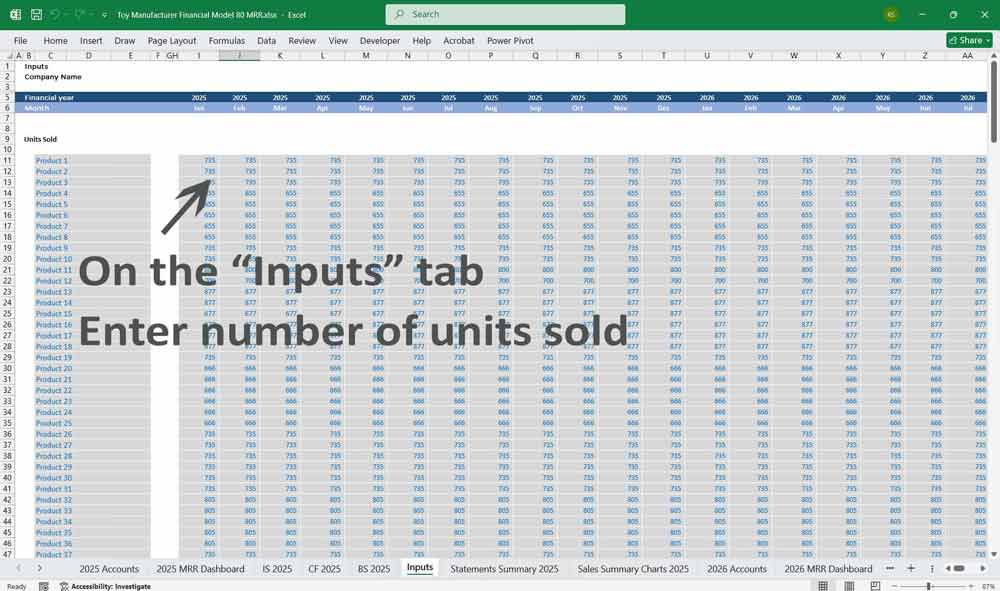
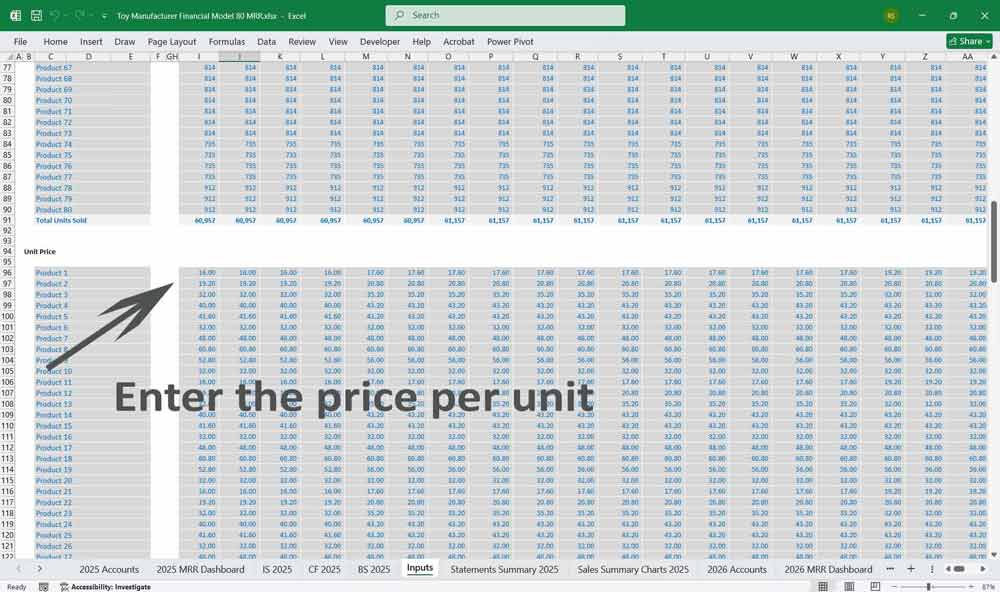
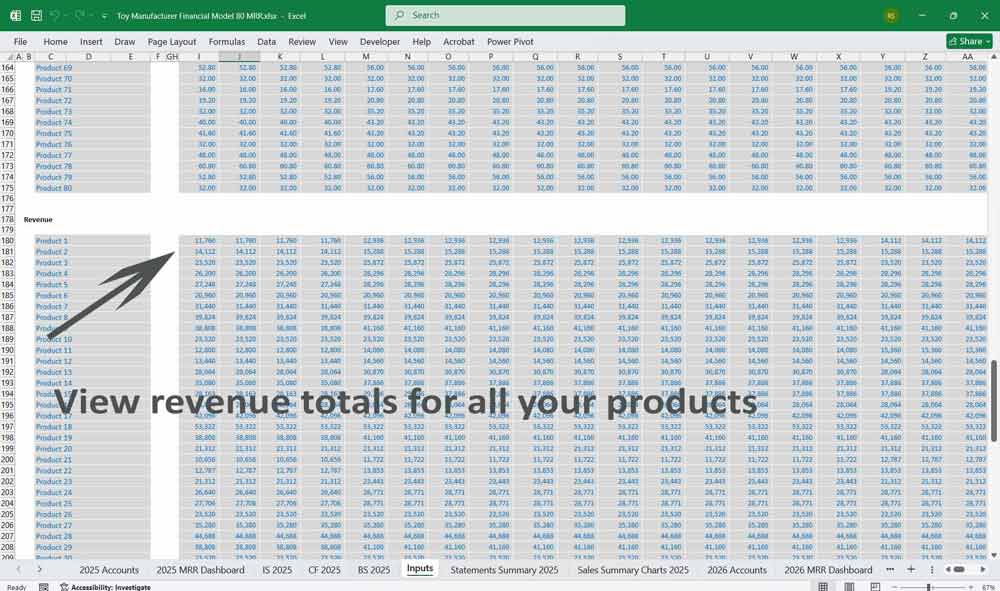
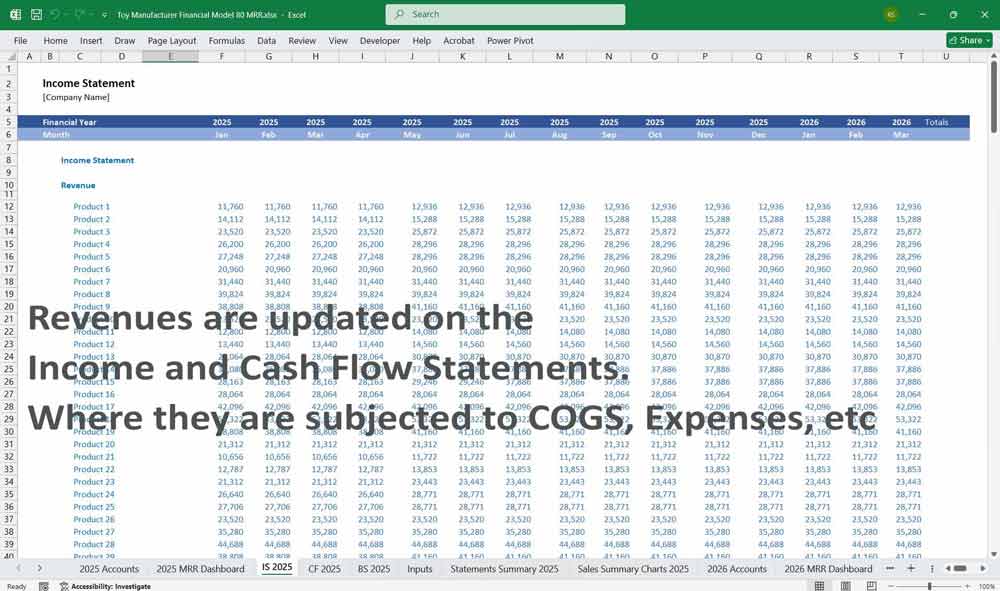
Toy Manufacturer Cash Flow Statement
The Cash Flow Statement tracks the inflows and outflows of cash, divided into operating, investing, and financing activities.
Key Sections:
Operating Activities:
Cash from Sales: Collections from customers (adjusted for accounts receivable).
Cash Paid to Suppliers: Payments for raw materials and manufacturing costs.
Operating Expenses: Cash outflows for R&D, marketing, and G&A.
Taxes Paid: Cash outflows for income taxes.
Net Cash from Operations: Sum of cash inflows and outflows from operating activities.
Investing Activities:
Capital Expenditures (CapEx): Purchases of machinery, equipment, or toy factory expansions.
Acquisitions: Cash spent on acquiring other companies or intellectual property.
Net Cash from Investing: Sum of cash inflows and outflows from investing activities.
Financing Activities:
Debt Issuance/Repayment: Cash inflows from new loans or outflows from repaying debt.
Equity Issuance: Cash inflows from issuing new shares.
Dividends Paid: Cash outflows to shareholders.
Net Cash from Financing: Sum of cash inflows and outflows from financing activities.
Net Change in Cash:
Calculated as Net Cash from Operations + Net Cash from Investing + Net Cash from Financing.
Ending Cash Balance:
Starting cash balance plus net change in cash.
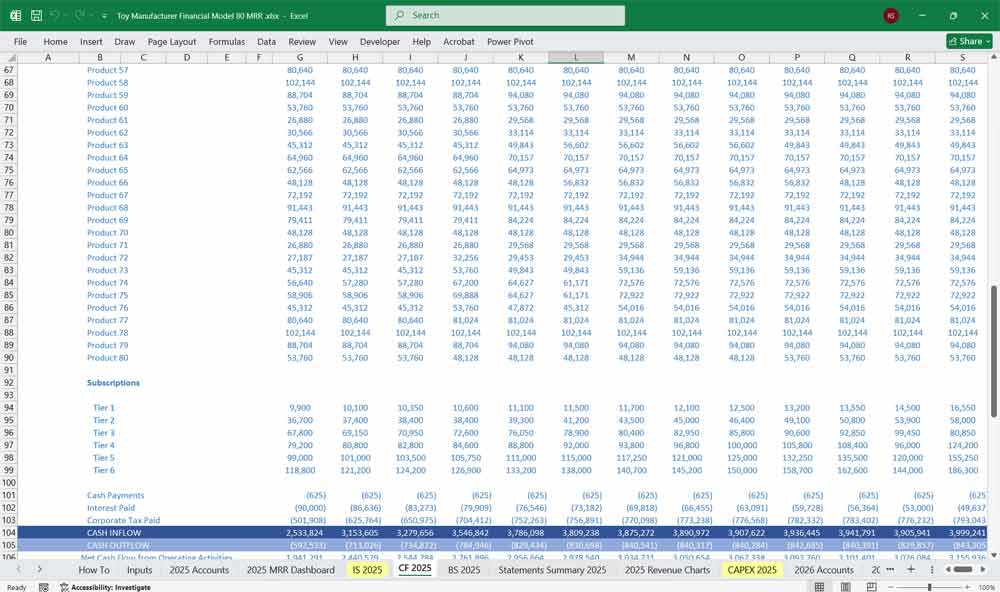
Toy Manufacturer Balance Sheet
The Balance Sheet provides a snapshot of the company’s financial position at a specific point in time, showing assets, liabilities, and equity.
Key Sections:
Assets:
Current Assets:
Cash and Cash Equivalents: Ending cash balance from the Cash Flow Statement.
Accounts Receivable: Amounts owed by customers for sales on credit.
Inventory: Raw materials, work-in-progress, and finished goods.
Prepaid Expenses: Payments made in advance (e.g., insurance, rent).
Non-Current Assets:
Property, Plant, and Equipment (PP&E): Factories, machinery, and equipment (net of depreciation).
Intangible Assets: Patents, trademarks, and licenses.
Goodwill: Excess paid over the fair value of acquired businesses.
Liabilities:
Current Liabilities:
Accounts Payable: Amounts owed to suppliers.
Accrued Expenses: Unpaid operating expenses (e.g., wages, utilities).
Short-Term Debt: Debt due within one year.
Non-Current Liabilities:
Long-Term Debt: Loans and bonds with maturities beyond one year.
Deferred Tax Liabilities: Taxes payable in future periods.
Equity:
Common Stock: Par value of issued shares.
Retained Earnings: Cumulative net income minus dividends paid.
Additional Paid-In Capital (APIC): Excess over par value from share issuances.
Total Liabilities and Equity:
Must equal Total Assets to ensure the Balance Sheet balances.
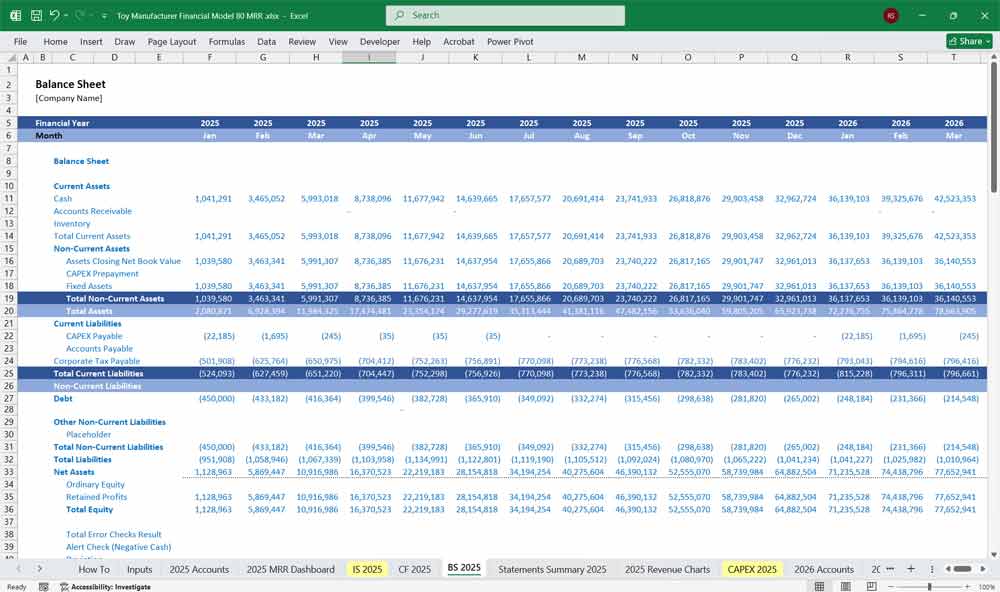
Key Assumptions and Drivers For A Toy Manufacturer
To build the financial model, you’ll need to make assumptions about key drivers:
Sales Growth: Based on market trends, product launches, and seasonality (e.g., holiday sales).
Pricing and Volume: ASP and unit sales projections.
COGS as % of Revenue: Reflects manufacturing efficiency.
Operating Expenses: Fixed vs. variable costs.
Working Capital: Days sales outstanding (DSO), days inventory outstanding (DIO), and days payable outstanding (DPO).
CapEx: Investments in new machinery or facilities.
Debt and Equity Financing: Capital structure and cost of capital.
When structuring product lines for a toy manufacturer, it’s important to organize them in a way that aligns with customer needs, market demand, and operational efficiency. 80 product lines, which might include categorization, examples, and strategic considerations.
Product Line Categorization for a Toy Manufacturer
A Toy Manufacturer Financial Model typically covers a wide range of products for different industries, including action, educational, remote control toys and speciality toys.
Action Toy Figures
Superhero Action Figures: Marvel, DC, and original superhero toy characters.
Movie Character Action Figures: Figures based on popular movie franchises (e.g., Star Wars, Jurassic Park).
Fantasy-Themed Action Figures: Knights, dragons, and mythical creatures.
Military-Themed Action Toy Figures: Soldiers, tanks, and military vehicles.
Animal-Themed Action Figures: Wild animals, dinosaurs, and mythical beasts.
Sports-Themed Action Figures: Athletes from various sports (e.g., soccer, basketball).
Historical Figures: Famous historical personalities (e.g., explorers, scientists).
Space-Themed Toy Action Figures: Astronauts, aliens, and spaceships.
Toy Dolls and Accessories
Fashion Dolls: Dolls with interchangeable outfits and accessories.
Baby Toy Dolls: Realistic baby dolls with feeding and care accessories.
Character Toy Dolls: Dolls based on popular TV shows or movies (e.g., Disney Princesses).
Customizable Dolls: Dolls with customizable features (e.g., hair, eyes, outfits).
Mini Dolls: Small collectible dolls with themed toy sets.
Dollhouses: Multi-level dollhouses with furniture and accessories.
Doll Clothing and Accessories: Separate outfits, shoes, and accessories for dolls.
Interactive Dolls: Dolls that talk, sing, or respond to touch.
Educational Toys
STEM Kits: Science, Technology, Engineering, and Math learning kits.
Coding Robots: Programmable robots that teach coding basics.
Building Sets: Construction kits for building structures or machines.
Puzzle Sets: Jigsaw puzzles, 3D puzzles, and brain teasers.
Math Learning Toys: Counting toys, abacuses, and math games.
Language Learning Toys: Toys that teach letters, words, and languages.
Science Experiment Kits: Kits for chemistry, physics, or biology experiments.
Musical Instruments for Kids: Mini pianos, drums, and toy xylophones.
Toy Board Games and Puzzles
Classic Board Games: Chess, checkers, and Monopoly.
Strategy Games: Games that require planning and critical thinking.
Cooperative Games: Games where players work together to achieve a goal.
Trivia Games: Question-and-answer games for different age groups.
Card Games: Uno, poker, and custom card games.
Escape Room Games: Puzzle-based games with a storyline.
Role-Playing Games: Games where players assume toy character roles.
Jigsaw Puzzles: Puzzles with varying difficulty levels and themes.
Outdoor and Sports Toys
Sports Equipment: Mini basketball hoops, soccer goals, and baseball sets.
Ride-On Toys: Tricycles, scooters, and pedal cars.
Water Toys: Water guns, inflatable pools, and sprinklers.
Sand Toys: Buckets, shovels, and sand molds.
Flying Toys: Kites, frisbees, and foam airplanes.
Camping Toys: Toy tents, flashlights, and binoculars.
Gardening Kits: Mini gardening tools and seed kits.
Adventure Sets: Explorer kits with compasses, maps, and binoculars.
Toy Electronics and Interactives
Robotic Pets: Interactive robotic dogs, cats, or dinosaurs.
Tablets for Kids: Child-friendly tablets with educational apps.
Interactive Globes: Globes that teach geography and culture.
Augmented Reality Toys: Toys that use AR for immersive play.
Voice-Activated Toys: Toys that respond to voice commands.
RC Vehicles: Remote-controlled cars, drones, and boats.
Electronic Learning Pads: Devices that teach math, reading, and writing.
Virtual Reality Kits: VR headsets with kid-friendly content.
Plush Toys
Stuffed Animals: Classic teddy bears, dogs, and cats.
Character Plushies: Plush toys based on popular characters.
Giant Plush Toys: Oversized stuffed animals for cuddling.
Interactive Plush Toys: Plush toys that talk or sing.
Customizable Plush Toys: Plush toys with interchangeable outfits.
Themed Plush Sets: Sets of plush toys (e.g., jungle animals, farm animals).
Emotional Support Plushies: Designed to comfort and reduce anxiety.
Collectible Plushies: Limited-edition plush toys for collectors.
Toy Building Blocks and Construction Sets
Classic Building Blocks: Wooden or plastic blocks for creative play.
Magnetic Building Sets: Magnetic tiles for building structures.
LEGO-Compatible Sets: Blocks that work with LEGO systems.
Architectural Sets: Kits for building famous landmarks.
Vehicle Construction Sets: Kits for building cars, planes, and ships.
STEM Building Kits: Kits that combine building with STEM learning.
Marble Run Sets: Sets for building marble tracks and mazes.
3D Construction Sets: Kits for building 3D models.
Toy Vehicles and Remote Controls
RC Cars: Remote-controlled cars with realistic features.
RC Drones: Drones with cameras for aerial photography.
RC Boats: Remote-controlled boats for pool or lake play.
RC Planes: Foam toy planes for outdoor flying.
Toy Trains: Electric train sets with tracks and accessories.
Die-Cast Vehicles: Miniature cars, trucks, and motorcycles.
Construction Vehicles: Toy bulldozers, cranes, and dump trucks.
Racing Tracks: Sets with loops, jumps, and obstacles for toy cars.
Seasonal and Holiday-Themed Toys
Christmas-Themed Toys: Ornaments, Santa figures, and holiday puzzles.
Halloween-Themed Toys: Costumes, masks, and spooky toys.
Easter-Themed Toys: Plush bunnies, egg decorating kits, and baskets.
Valentine’s Day Toys: Heart-shaped plush toys and love-themed games.
Summer-Themed Toys: Beach toys, water slides, and outdoor games.
Winter-Themed Toys: Snowball makers, sleds, and snowman kits.
Birthday-Themed Toys: Party favors, balloons, and cake toppers.
Cultural Celebration Toys: Toys for Diwali, Hanukkah, or Lunar New Year.
Key Considerations for Toy Product Lines
Target Audience: Age group, gender, and interests.
Price Point: Budget-friendly, mid-range, or premium.
Materials: Plastic, wood, fabric, or electronic components.
Safety Standards: Compliance with safety regulations (e.g., CPSIA, ASTM).
Packaging: Eco-friendly, attractive, and functional.
By offering a diverse range of product lines, the toy manufacturer can cater to various customer preferences, expand market reach, and drive revenue growth.
6-tier subscription model for a Toy manufacturer
This involves structuring offerings that cater to different customer segments, from small businesses to large enterprises. Each tier should provide increasing value, services, and benefits to justify the higher price points.
Tier 1: Basic Toy Subscription
Target Audience: Budget-conscious families or first-time subscribers.
Price: 10–15/month.
Features:
Monthly Toy Delivery: 1–2 age-appropriate toys per month.
Educational Focus: Toys that promote learning (e.g., puzzles, building blocks).
Rotational Play: Toys are returned after a month for new ones.
Basic Packaging: Simple, eco-friendly packaging.
Digital Content: Access to online play guides and activity sheets.
Customer Support: Email support for questions or issues.
Tier 2: Premium Toy Subscription
Target Audience: Families seeking higher-quality toys and more variety.
Price: 25–25–35/month.
Features:
Monthly Toy Delivery: 3–4 high-quality toys per month.
Brand-Name Toys: Includes popular brands (e.g., LEGO, Melissa & Doug).
Educational and Developmental Toys: Focus on STEM, creativity, and motor skills.
Personalized Selection: Toys tailored to the child’s age and interests.
Eco-Friendly Packaging: Sustainable and reusable packaging.
Digital Content: Access to exclusive online games and learning apps.
Tier 3: Deluxe Toy Subscription
Target Audience: Families looking for premium, exclusive, and personalized experiences.
Price: 50–50–70/month.
Features:
Monthly Toy Delivery: 4–5 premium or exclusive toys per month.
Customization: Toys selected based on detailed child profiles (age, interests, developmental stage).
Limited-Edition Toys: Access to exclusive or hard-to-find toys.
Interactive Toys: Includes electronic or interactive toys (e.g., coding robots, AR toys).
Luxury Packaging: Premium, gift-like packaging with personalized notes.
Priority Customer Support: Dedicated phone or chat support.
Tier 4: Toy Collector’s Subscription
Target Audience: Collectors and enthusiasts of specific toy categories (e.g., action figures, dolls).
Price: 75–75–100/month.
Features:
Monthly Collectible Delivery: 1–2 high-value collectible toys per month.
Exclusive Items: Limited-edition or rare collectibles (e.g., signed action figures, vintage dolls).
Certificates of Authenticity: Proof of exclusivity and value.
Display Packaging: Collectible-grade packaging for display purposes.
Community Access: Membership in an exclusive collector’s community (e.g., forums, events).
Early Access: First dibs on new releases and pre-orders.
Tier 5: Ultimate Family Toy Games Subscription
Target Audience: Families with multiple children seeking a comprehensive solution.
Price: 120–120–150/month.
Features:
Monthly Toy Delivery: 6–8 toys per month, tailored to multiple children.
Age-Specific Selection: Toys for different age groups (e.g., toddler, preschooler, school-age).
Educational and Fun Mix: Combines learning toys with recreational toys.
Family Activities: Includes toys or games for family playtime (e.g., board games, outdoor toys).
Personalized Experience: Customized selections for each child.
Premium Support: Dedicated account manager for personalized service.
Tier 6: VIP Luxury Toy Games Subscription
Target Audience: High-net-worth individuals seeking the ultimate luxury experience.
Price: $200+/month.
Features:
Monthly Luxury Delivery: 4–6 ultra-premium or custom-made toys per month.
Bespoke Toys: Custom-designed toys based on the child’s preferences.
Luxury Brands: Includes high-end toy brands (e.g., Steiff, KidKraft).
Exclusive Experiences: Access to VIP events (e.g., toy launches, meet-and-greets with designers).
Luxury Packaging: High-end, gift-ready packaging with personalized touches.
Concierge Service: 24/7 concierge for toy selection, delivery, and support.
Key Benefits Across All Tiers
Convenience: Regular deliveries eliminate the need for frequent toy shopping.
Sustainability: Rotational or eco-friendly toys reduce waste.
Personalization: Tailored selections enhance customer satisfaction.
Exclusivity: Higher tiers offer unique, hard-to-find items.
Community: Access to exclusive content, forums, or events.
Flexibility: Options to upgrade, downgrade, or cancel anytime.
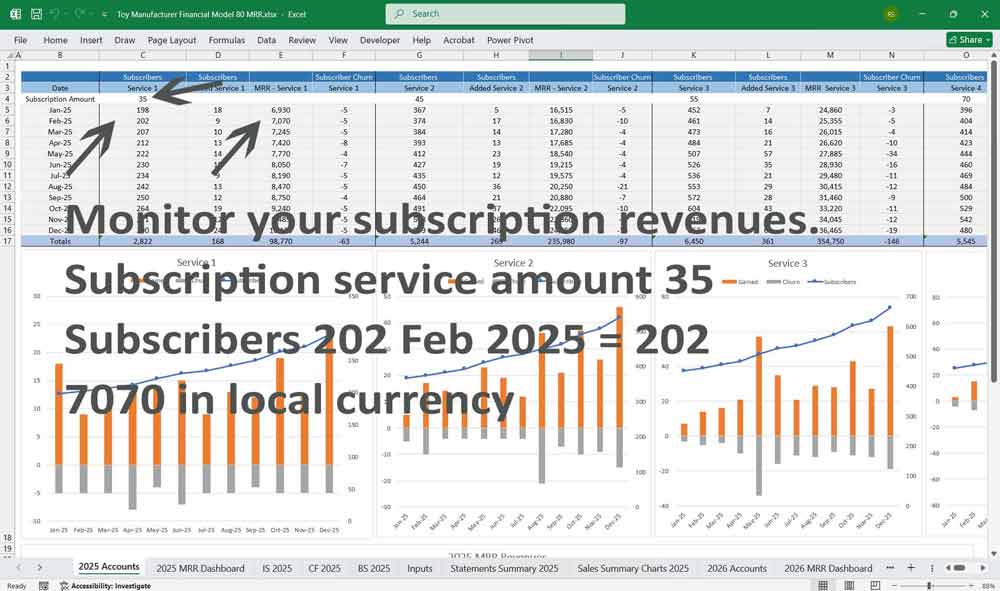
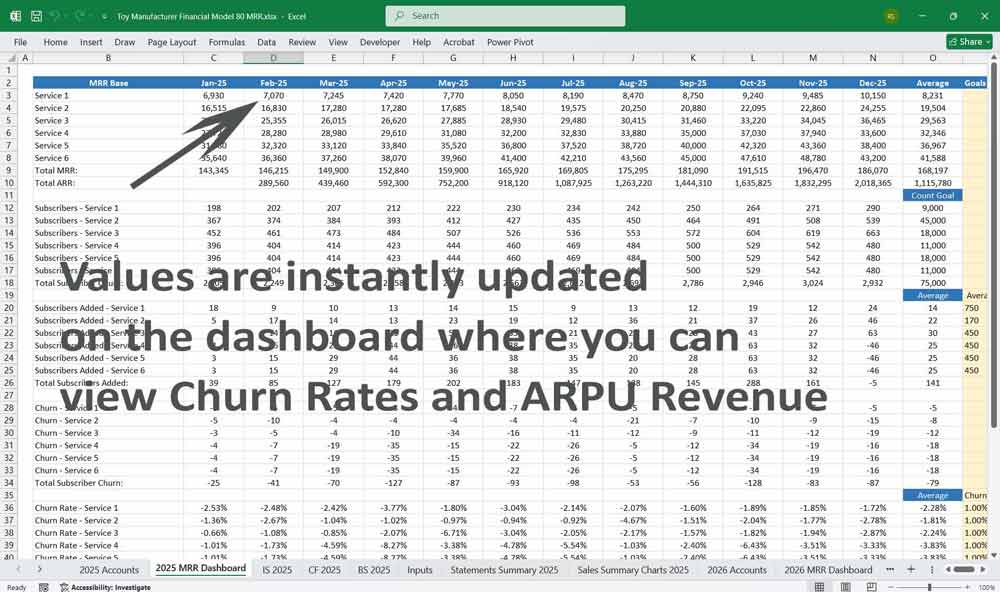
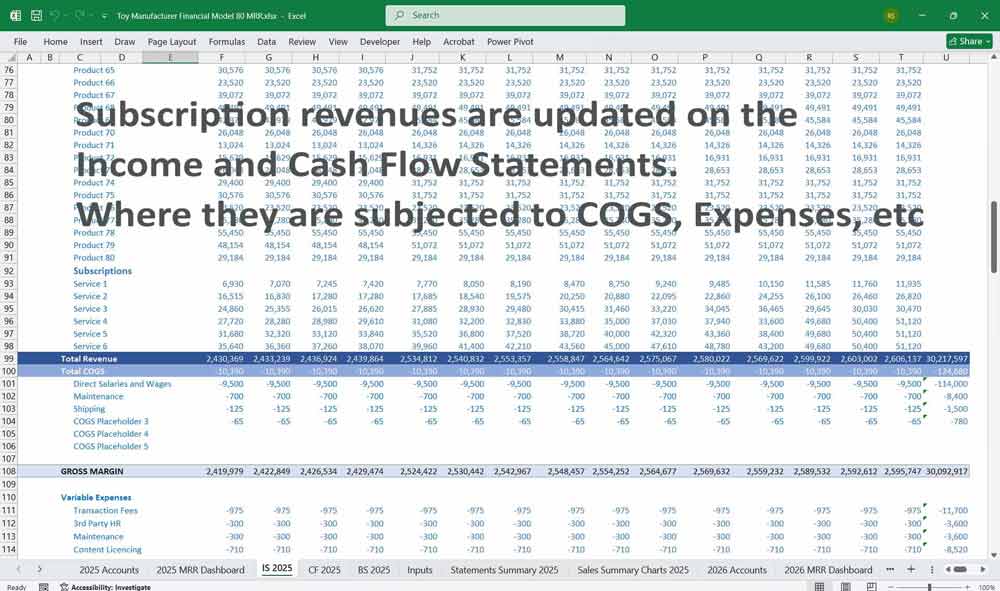
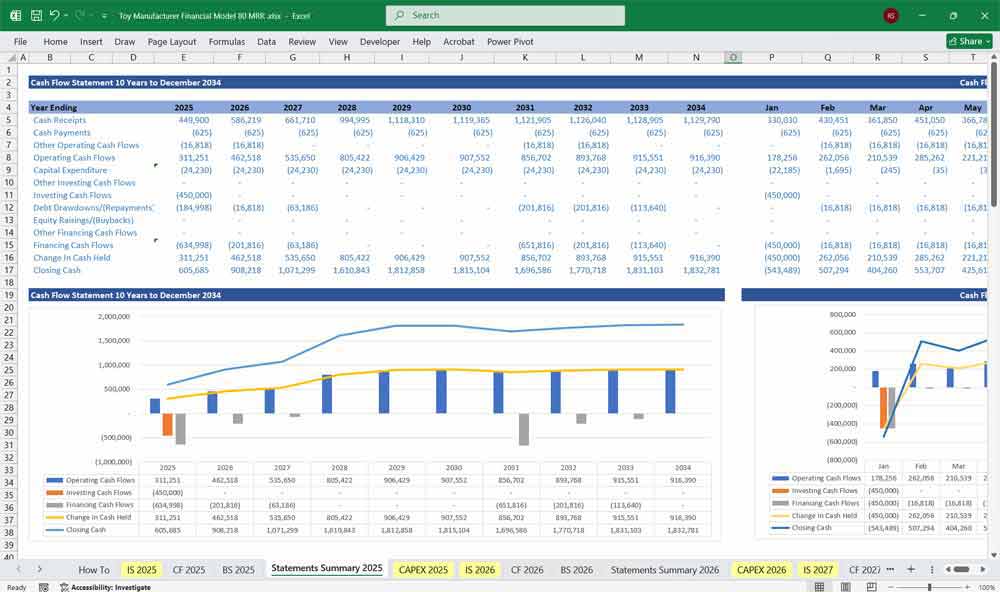
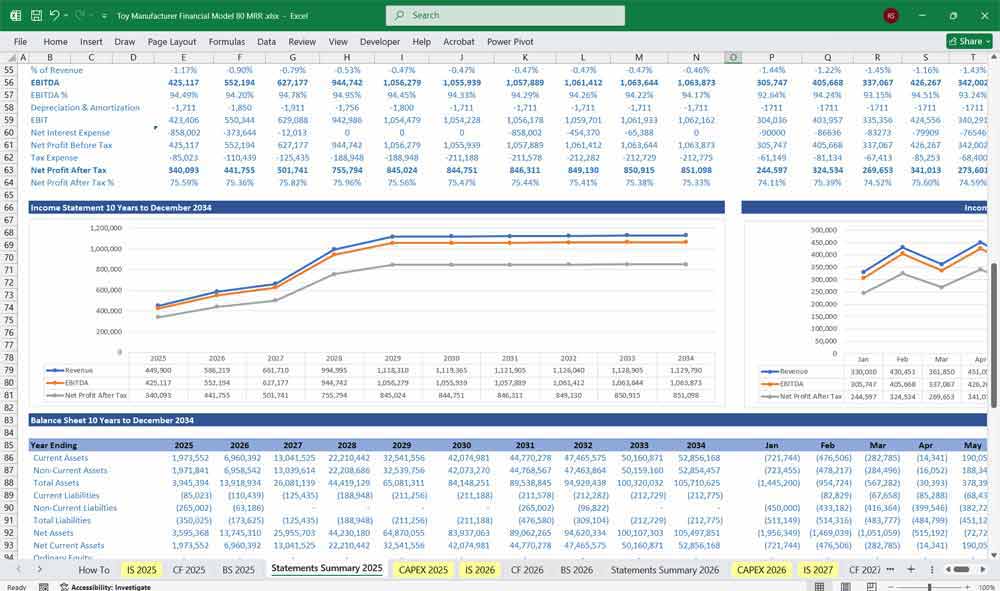
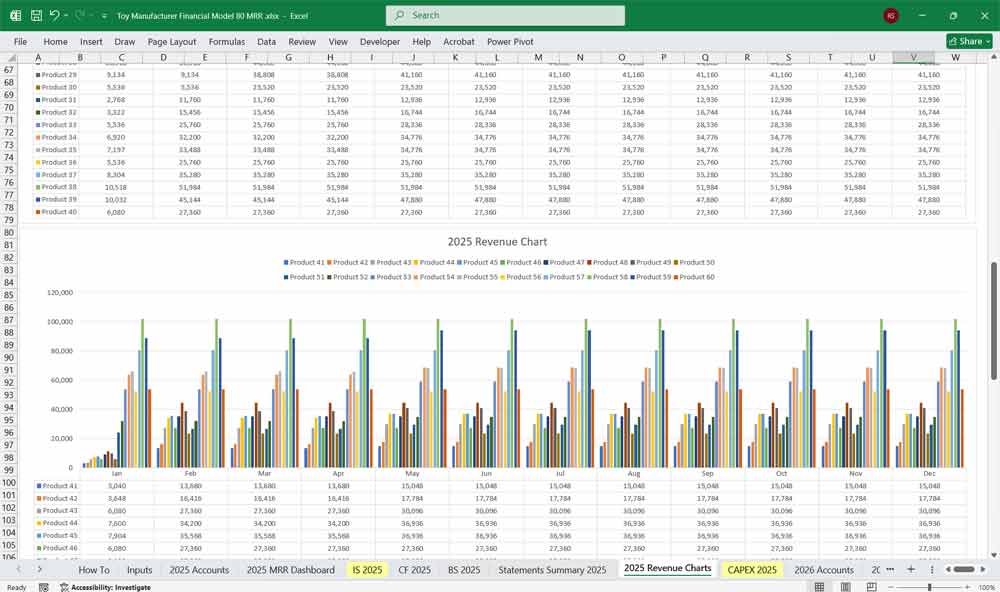
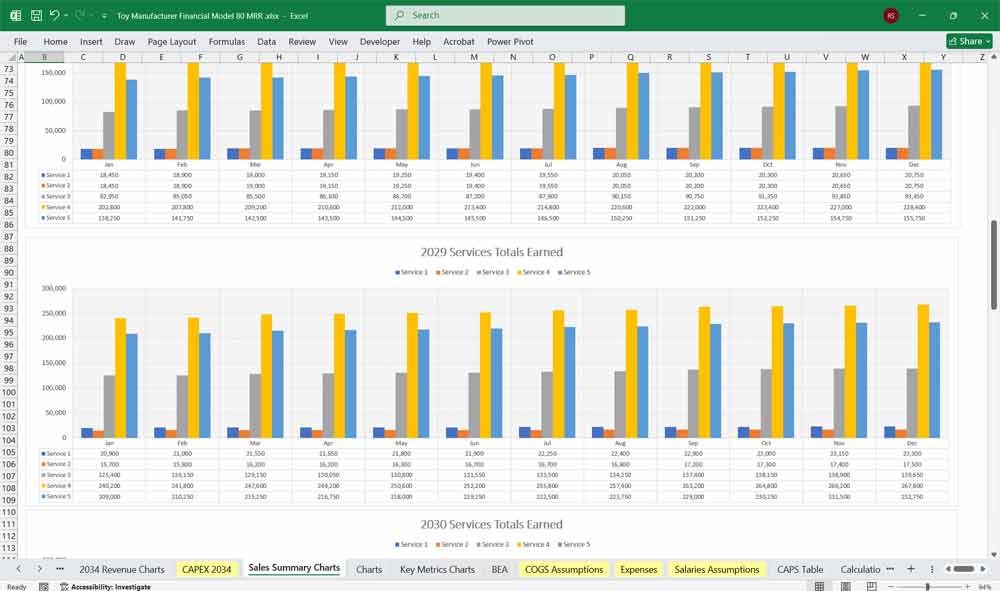
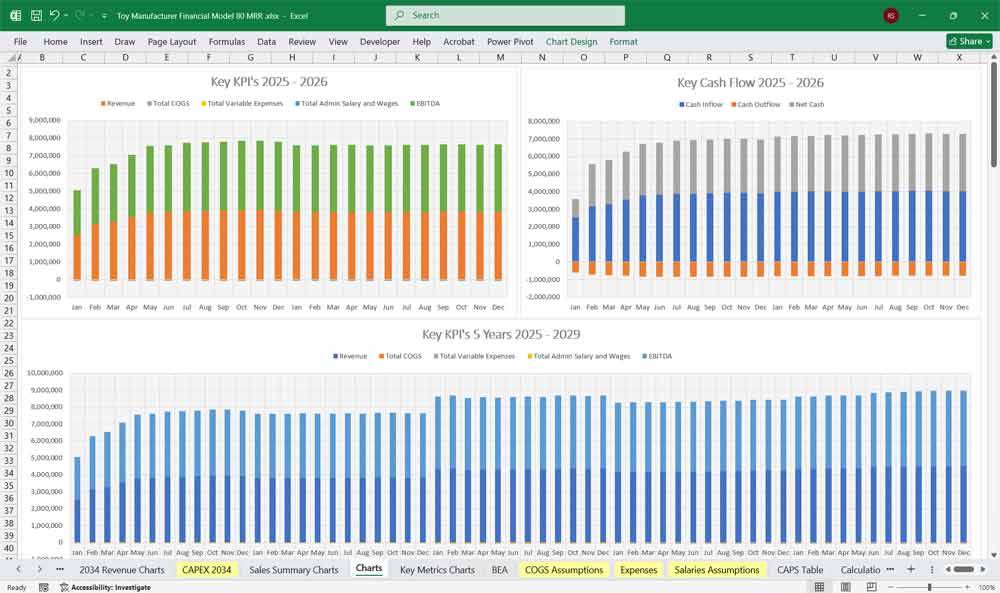
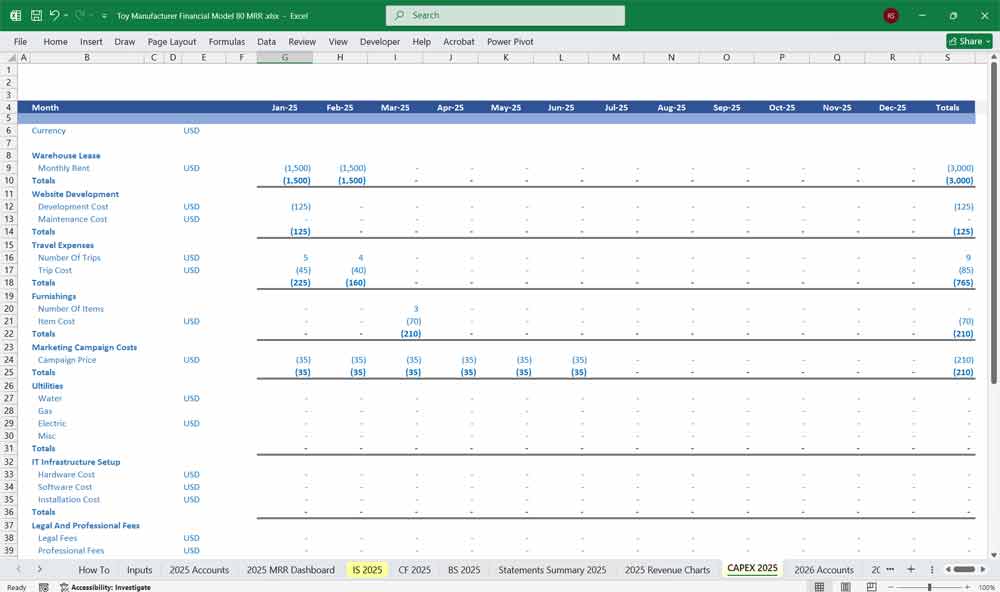
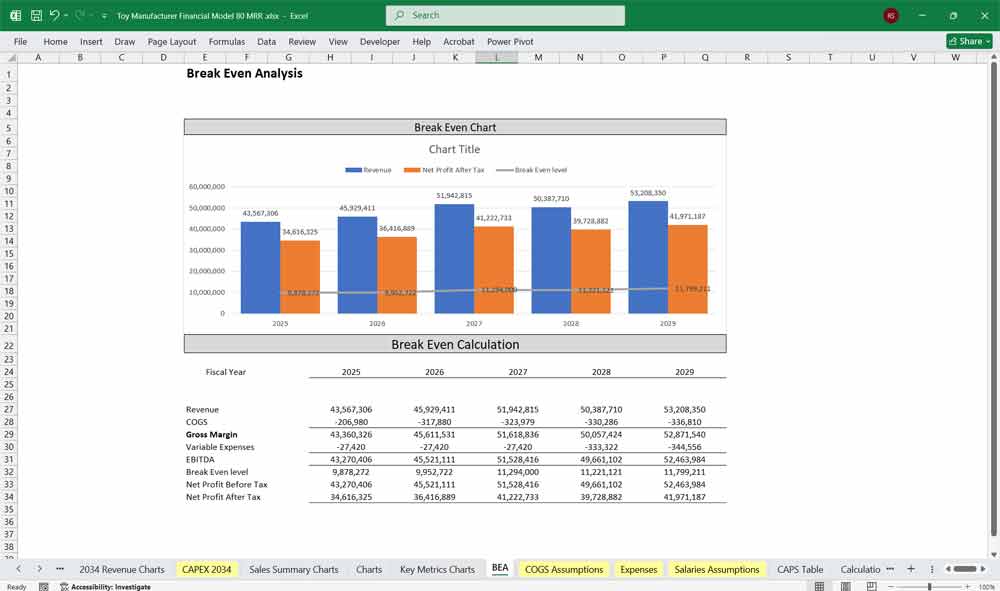
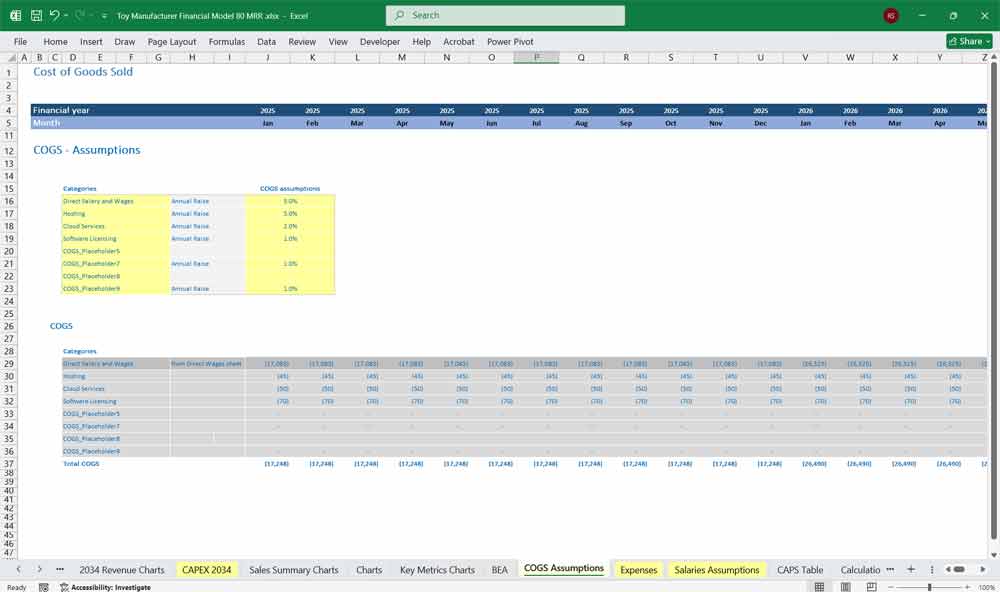
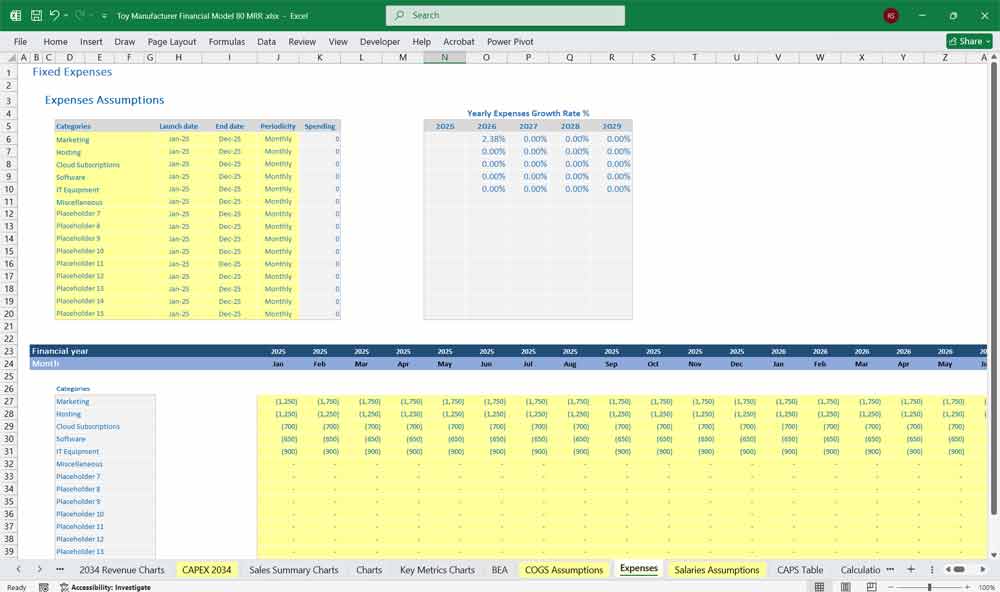
Final Notes on the Financial Model
20 Year Financial model for a Toy manufacturer
- Scenario Analysis: Create best-case, base-case, and worst-case projections.
- Break-even Analysis: Determine sales volume required to cover fixed & variable costs.
- Sensitivity Analysis: Assess how changes in raw material costs, pricing, or demand impact profitability.
This structured model will help any Toy manufacturer address a broad market spectrum, offering the right balance between cost, production capacity, and support.
Download Link On Next Page
